#Minneapolis college of art and design
Explore tagged Tumblr posts
Photo

Visiting artist, Adrian Piper, lecturing at the Minneapolis College of Art and Design, 133 East 25th Street, Minneapolis, Minnesota
Description: This photograph shows visiting artist, Adrian Piper, speaking to a seminar class. We see her with a chalk board, where she has noted items of interest. She was at MCAD from Oct 24-28, 1983 as part of the series, "The Power of Art: The Language of Images". The Minneapolis College of Art and Design was previously named the Minneapolis School of Fine Arts from 1886-1909 and the Minneapolis School of Art from 1910-1969.
Inscription: verso-(in ink pen) "Word Works Adrian Piper - lesson in Funk" "No Negatives see -" (Stamped) "PHOTO RIK SFERRA ©", (in ink pen) "Oct. 1983"
Creator: Sferra, Rik
Date of Creation: October 1983
Item Type: Still Image
Item Physical Format: Gelatin silver print
Dimensions: 20.3 cm x 25.3 cm
MCAD Library
40 notes
·
View notes
Text

Everything is Strange
A Library Gallery exhibition by Anna Lyle
There is a new exhibition in the Library Gallery! Please make some time to visit the MCAD Library to see Anna Lyle's exhibition: Everything is Strange.
Exhibition: Wednesday, January 18–Tuesday, February 7 MCAD Library Gallery
Exhibition Introduction by the artist: Over the past few years, I have been creating work representing fabric and the human figure, intersecting and morphing into each other. This exploration began as small graphite drawings on paper a few years ago. These tiny, intricate, and obscure drawings are very curious to me and led to me branching off into large drawings on paper, large paintings on paper, and then drawings on wood panel. There are many modes that this morphing and intersection has taken in my visual work. In between these drawings on paper, paintings on paper, and drawings on wood panel, I created more formal paintings on wood panel that spoke to a more crisp and clear reality of fabric and figure interacting in the same space (www.annalyle.com/unraveling). These works truly informed my more abstract "anatomical fabric" pieces, mining conceptual inspiration from deconstructing ideologies and learning about place and purpose in the world outside of the Southern Baptist Christian culture in which I grew up.
For this particular exhibition, I am showing my process to final creation; the whole breadth of study. I find that seeing these various scales and modes of abstraction through mark-making intertwining with the figure is intriguing and a deep well of discovery for the viewer.
Recommended library books:
Alison Watt: Fold: New Paintings,1996-97, by Alison Watt
All Wet: Marilyn Minter, by Marilyn Minter, David Desrimais, and Mathieu Cénac
Gender/body/knowledge: Feminist Reconstructions of Being and Knowing, by Alison M. Jaggar and Susan Bordo
The Wisdom of Insecurity: a Message for an Age of Anxiety, by Alan Watts
Existential Psychology, by Rollo May
*Due to COVID-19 campus access has been modified. Please continue to check the school’s COVID-19 page for updates.
#mcadlibrarygallery#librarygallery#mcad#librarygallery@mcad#Minneapolis college of art and design#mcad library gallery#library gallery#library gallery @mcad
3 notes
·
View notes
Text








It’s Fine Press Friday!
On this first Friday of the New Year, we’re delighted to highlight the work of book artist and UWM Art & Design faculty member Melissa Wagner-Lawler. In Solitude was printed by Red Thread Letterpress in June of 2023 as part of the In Cahoots Residency in Petaluma, California, in a limited edition of 30 copies signed by the artist. Wagner-Lawler created both the text and images, which were letterpress and relief printed. The font is Optima 14.
The spare prose cuts across the images; images and phrases wrap around pages; ideas linger (mostly) unpunctuated, unresolved, “existing in expansiveness.” The central signature folds out in a long accordion revealing a verdant, abstract solitude. The book lives in a turquoise clamshell box. In the colophon, Wagner-Lawler explains that the book was created “in an old horse barn” at Macy Chadwick’s In Cahoots Residency. (Back in December we featured some of Chadwick’s work produced at In Cahoots.)
Wagner-Lawler studied printmaking at both the Milwaukee Institute of Art and Design and the Minneapolis College of Art and Design. At UWM she teaches in the Printing and Book Arts area of Art & Design, as well as the First Year Program. Her work is featured in collections across the country, including the Smithsonian American Art & Portraiture Library, Yale University, Stanford University, Library of Congress Rare Books Collection, and, of course, UWM’s Special Collections.

Watch a brief exploration of another Wagner-Lawler book by Bainbridge Island Museum of Art.
View other posts related to Melissa Wagner-Lawler.
View other Fine Press Friday posts.
--Amanda, Special Collections Graduate Intern


#Fine Press Friday#Fine Press Fridays#finepressfriday#finepressfridays#In Cahoots#Melissa Wagner-Lawler#Red Thread Letterpress#In Cahoots Residency#UWM#Peck School of the Arts#UWM Art & Design
20 notes
·
View notes
Text
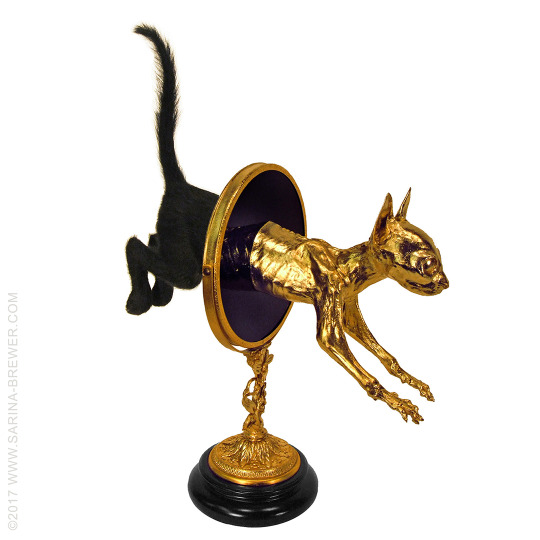
A tribute to two cherished individuals ~
I began gilding preserved animals in the early 1990s while earning my BFA at the Minneapolis College of Art & Design and they remain my favorite things to create. Out of all of them, this is my very favorite. This was a commission from 7 years ago but I have waited until now to post it because of the emotional nature of this piece and the meaning it has to its owner. The client originally commissioned it to memorialize her deceased black cat, named “Muse”. Then, only several months after having the sculpture in her possession, my client’s daughter died unexpectedly. As a result, this piece took on additional layers of meaning for her because she saw it also representing her child passing to the other side. I haven’t spoken with her since she relayed the tragic news to me, but I hope her memories have brought her comfort with the passage of time, and that this piece is among the things that evokes them.
TITLE: Musings of an Afterlife MATERIALS: Taxidermy kitten, gold leaf, vintage ormolu mirror with opaque black glass insert.
More of my work at www.Sarina-Brewer.com ~ The philosophical foundation of my work dictates no animal should die for the sake of art. Throughout the course of my career I have exclusively used humanely-sourced animals. Roadkill and natural deaths are my staples. Each sculpture is an hommage to the animal and a celebration of their enduring beauty in life and in death. Google me for more about the no-kill ethics platform I introduced and my role in its popularization.
73 notes
·
View notes
Text


August is a happenin' month for me! I've got no less than 4 events going on in the next two weeks here in the Twin Cities. (More details at my Patreon!)
SATURDAY 8/10
I will be the visiting the Columbia Heights Public Library as part of their Saturday Scribes author series to discuss my books and career as a comic artist!
10:30 am, Columbia Heights Public Library, Columbia Heights
FRIDAY 8/16
As the first event of Autoptic weekend, I will be doing a live reading of my short comic "Little Islands" from the anthology Failure to Launch! Join me and my fellow cartoonists Beth Hetland, Chad Bilyeu, Trung Le Nguyen, Anders Nilsen, and Bianca Xunise as we perform our work in front of an audience.
6:30 pm, Highpoint Center for Printmaking, Minneapolis
SATURDAY 8/17
This is my selling day during Autoptic weekend! Find me at Table 58A, where I'll be selling my graphic novels as well as copies of Failure to Launch and my entire Ghostbusters run.
11 am - 6 pm, Coffman Memorial Union, Minneapolis
SUNDAY 8/18
Panel day! I am moderating the "Queer Identity in Comics" panel at MCAD. Join me and fellow artists Sarah Evenson, Frannie Love, and Xiomar Luna as we talk about our journeys making LGBT+ comic work.
3 pm, Minneapolis College of Art and Design, Minneapolis
35 notes
·
View notes
Note
Hey JSTOR! Do you do recommendations from your database?
If so, you got anything on fairy tale scholarship?
Please and thank you 😁
Hi there!
If you're into artistic representations, we recommend Edmund Dulac's Fairy-Book (1916), part of an open access collection from the Minneapolis College of Art and Design. Here you can find a few beautiful illustrations based on fairy tales from across Eurasia!
If you're up for reading, another open access excerpt comes from Fairy Tale Films: Visions of Ambiguity's first chapter. This chapter discusses films based on fairy tales–chiefly, ideas around the generic idea of a fairy tale and its interplay with gender construction. You'll find recommended related texts in the sidebar!
Happy exploring 🧚
#jstor#fairy tales#open access#art#academic research#edited bc edmund autocorrected to edward i’m so sorry
170 notes
·
View notes
Text
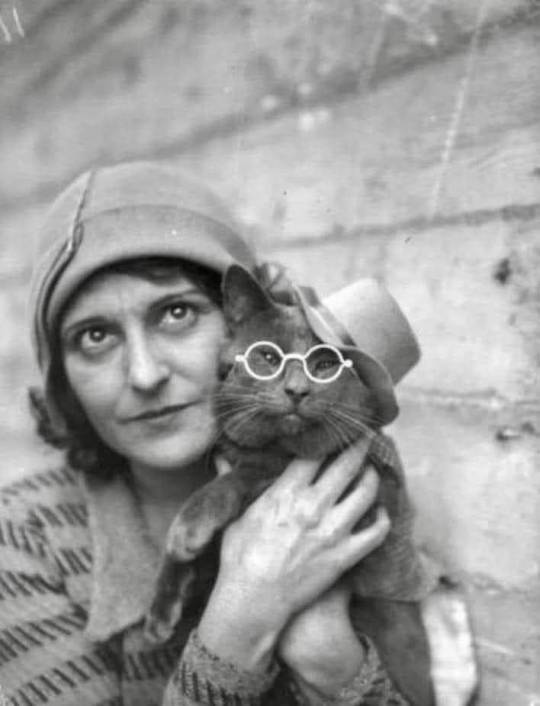
Author Wanda Gag in the late 1920s with a furry feline friend.
A New Ulm, Minnesota native and Minneapolis College of Art and Design alumni, Gag is best known for writing and illustrating the children's book Millions of Cats in 1928; it remains the oldest American picture book still in print.
#wanda gag#minneapolis#minnesota#twin cities#history#travel#midwest#aesthetic#wanderlust#vintage#retro#cats#millions of cats#books#reading
80 notes
·
View notes
Text

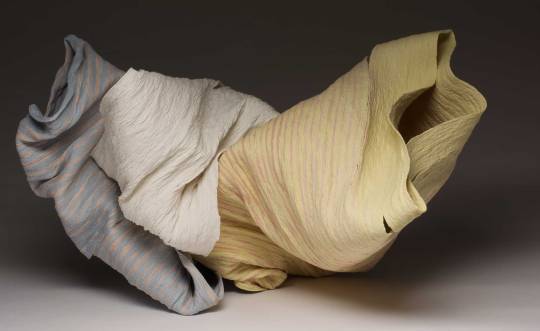

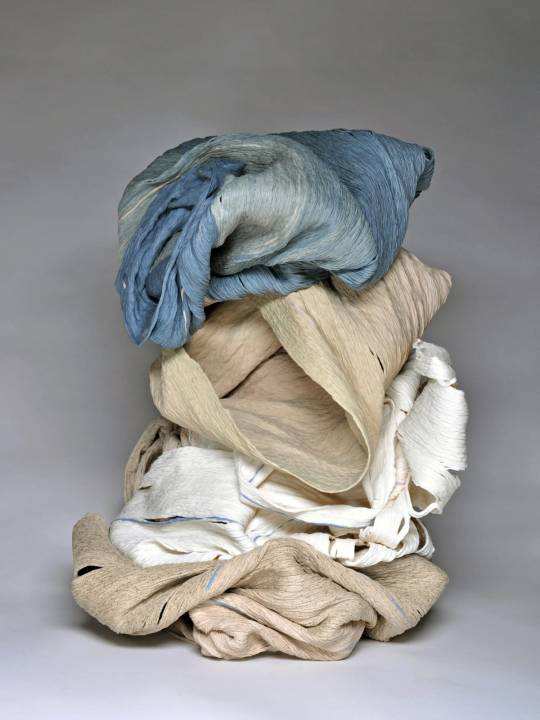
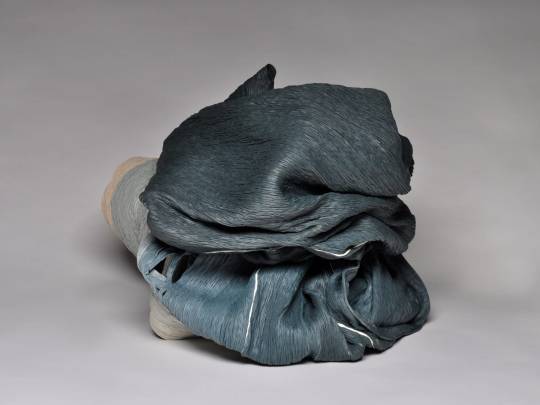

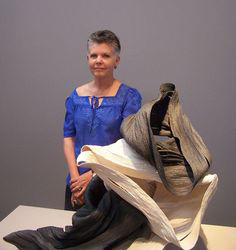
CHERYL ANN THOMAS, Hand-coiled porcelain ceramic.
Coiling together thin, serpentine ropes of porcelain, American artist Cheryl Ann Thomas begins her sculptures with one of the most traditional techniques of pottery. Used by Pre-Columbian, Native American and West African peoples to hand-build large storage jars, coiling has a rich history in the ceramic world. Traditionally the coils were smoothed together and integrated, but Thomas leaves the twists of clay exposed, and imprinted with the mark of her hand. Speaking about her work, Thomas asserts that “relics or artifacts are the remains of a human intervention. These sculptures form a permanent record of my interaction with the material.”
Once she has constructed tall, thin vessels of coiled porcelain, Thomas fires them, and the weight of the clay causes the works to collapse and fold in on themselves unpredictably. Her early works were the outcomes of this process, while more recently the artist has begun combining these forms and firing them for a second time, creating assembled sculptures of greater scale and power. After firing her pieces and leaving the results to chance, “the resulting forms are exquisite and very delicate, richly open-ended in their associations,” according to Constance Mallinson for Art in America.
Thomas’s work is frequently noted for its allusions to the transience and delicacy of existence. Although the heat of the kiln is what causes the collapse of her forms, it also gives the porcelain she uses its durability and strength. In this way, the artist notes that her work “is not a metaphor, but a real and distinct experience of creation and loss.” Thomas has recently expanded her output to include works in bronze and stainless steel, which continue her meditations on fragility.
Cheryl Ann Thomas graduated from the Art Center College of Design in 1982, and has emerged as a ceramic sculptor within the past 13 years. She has been featured in solo and group shows in New York and Los Angeles and her work is included in the collections of the Long Beach Museum of Art, the Minneapolis Institute of Arts, and the Gardiner Museum in Toronto.
53 notes
·
View notes
Text

PARADI5E is a fictional girl-group signed to Doucet Records. They released their first single MANTRUM on August 25, 2023.
The group was created through Finding Paradise, a show seeking to find the next big girl group. Over the course of fifteen weeks girls were eliminated until only five remained. The members are : Chloé "Coco" Burton, Axelle Ryder, Lennon Sun, Josie Rolland, and Paloma Vidal. Their fame came quickly. Soon personal lives became non-existent and Instagram followers quadrupled.
Follow the girls of PARADI5E as they take over the world.

Chloé "Coco" Harlow Burton was born on October 31, 2000 in the suburbs of Minneapolis, Minnesota. She is the middle child of her family and the only girl. Coco does not currently have a relationship with her family.
Music was a "later in life" passion for Coco. Originally, she wanted to be fashion designer. For years she was set on attending FIT and dress Hollywood snobs in the most magnificent clothing. This dream came to a halt when Coco met Axelle. It was freshman year when Coco and Axelle became best friends. There was no separating the girls, they did everything together. Axelle introduced her to the art of sneaking into karaoke bars and singing; Coco has not looked back since. She became obsessed with learning to play the guitar and write her own songs. Axelle taught Coco how to read sheet music and how to use Garage Band. Coco took a leap of faith and applied to Berklee College of Music. She got in. Axelle was not as lucky.
When Coco left for college, she and Axelle lost touch. Coco tried her hardest to hold onto her friend, but was unable to maintain their relationship while in Boston. When she came back for Christmas break her sophomore year of college, Coco ran into Axelle at a party. They talked until three in the morning. Coco kissed Axelle then did not speak to her until the televised auditions of Finding Paradise.
WHAT PLACE / AMOUNT OF VOTES : Coco finished first with 6.3 million votes. She was consistently a fan-favorite.
INSTAGRAM FOLLOWER COUNT : 11.2 million

Shufen "Lennon" Sun was born on March 17, 1998 in Bakersfield, California. She is the only child of a single mother.
Most of Lennon's life was dedicated to working in show business. Her mother, a talent agent, made sure that her daughter would never live a normal life. Lennon started out as a child actress, doing the occasional commercial and guest spot on Disney channel. When she entered her teen years, Lennon became a model. She was signed to Versace for a number of years before moving to Gucci. She gained a large internet following before she even reached her twenties.
Before landing PARADI5E, Lennon was involved with some callbacks for some network comedy but had to back out due to time conflicts.
WHAT PLACE / AMOUNT OF VOTES : Lennon finished second with 6 million votes. She was consistently a fan-favorite. Her fanbase assumed she would end up first so they did not turn out for Lennon.
INSTAGRAM FOLLOWER COUNT : 17 million

Axelle Juanita Ryder was born on September 9, 2000 in Phoenix, Arizona. She is the youngest of four girls.
Axelle was born into a family of musicians. Her father was a classically trained pianist, her mother was a music teacher, and her sisters would go on to become producers, sound techs, and back-up singers. It was only natural for Axelle to have a knack for all things music.
A few months before freshman year, the Ryder family moved to Minneapolis in order to be closer to extended family. On the first day of school Axelle met Coco. Coco was the coolest person she had ever met. She made Axelle want to be more carefree and unapologetic. In return, she taught Coco everything she knew about music. They applied to Berklee together, but only Coco got in. Axelle ended up going to the University of Minnesota to study English. Her bitterness towards Coco sucked the joy from their friendship. Axelle held onto this resentment for years. Then when they met again at a Christmas party, she thought they could rekindle their friendship. That was before Coco kissed her and disappeared once again.
WHAT PLACE / AMOUNT OF VOTES : Axelle finished third with 5.5 million votes. She was always on the cusp of eliminations until the ninth episode.
INSTAGRAM FOLLOWER COUNT : 8 million

Josephine "Josie" Heather Rolland was born on July 12, 1997 an hour west of St. Petersburg, Florida. She is the oldest of two. Josie and her sister were raised by their maternal grandparents.
Josie grew up in a trailer park. She learned how to play the harmonica and the bongos from one of her neighbors a few trailers down. Josie was okay at playing instruments, but God did she have a beautiful voice. Come middle school she would always be cast as the lead in whatever production the school was doing. Josie sang in chorus and sang at a shitty little bar down the road.
She dropped out of high school to focus on her music. For years Josie would busk and sing at weddings to make ends meet. In 2021 she was able to open for the punk band Holy Destiny. For a brief period of time she was a back-up singer for them as well. She dated the lead singer and lived a comfortable life before he cheated on Josie with a groupie. After this heartache she decided to try out for Finding Paradise.
WHAT PLACE / AMOUNT OF VOTES : Josie finished fourth with 4.9 million votes.
INSTAGRAM FOLLOWER COUNT : 6.5 million

Violeta "Paloma" Vidal was born on December 28, 2001 in Houston, Texas. She has an older brother.
Paloma is very quiet regarding her personal life. Many have their own fantastical speculations about why Paloma would rather not talk about her life before PARADI5E. In truth, she is an un-successful nepotism baby and is trying her damndest to keep that fact from getting out.
Fans of PARADI5E don't really care about Paloma. She doesn't exactly add much to the group. Many are confused about how she was able to get in the group over other girls
WHAT PLACE / AMOUNT OF VOTES : Paloma finished fourth with 4 million votes. She was 1,000 votes ahead of the girl behind her.
INSTAGRAM FOLLOWER COUNT : 3 million
#( PARADI5E ) / * PROFILE .#celebrity oc#girl group#fake girl group#idolverse#oc writing#singer au#singer oc#girl group au
11 notes
·
View notes
Text
Edmund Dulac's Fairy Tales go to War
Jstor Daily published an article with the catchy title "Edmund Dulac's Fairy Tales go to War". Of course I had to read it. The original article is here if you want to check it out, but I'll still copy-paste it below because it's crazy info. (And given it is quite long I will put two thirds of it under a cut)
Edmund Dulac’s Fairy Tales Go to War One of the best-known illustrators of the “golden age of children’s gift books,” Dulac was also a subtle purveyor of Allied propaganda during the Great War.
By: S. N. Johnson-Roehr and Jonathan Aprea ; December 16, 2022
Once upon a time, there was a young artist named Edmund Dulac, who built his early reputation on his illustrations for J. M. Dent & Company’s 1905 edition of Jane Eyre. Almost instantly, he became a leading name in the book arts, producing illustrations for the Brontë sisters and popular magazines. Annual exhibitions of his drawings and paintings at the Leicester Galleries, London, drew the attention of both the European and American art world. In 1910, critic Evelyn Marie Stuart, writing for Chicago’s The Fine Arts Journal, described his work as “rich with poetry and imagination, and strong in the possession of that decorative element which renders a picture universally pleasing.” His drawings were like "things seen in a vision or a mirage; or traced by the fancy of a child in the lichens on the wall, the water discolorations upon a ceiling, or the light shining through a broken crumpled shade; or, even like the things we try to decipher in the leaping flames and glowing embers of an open fire—many of these delightful sketches suggest to our fancy in some detail a variety of objects."
Dulac’s themes tended toward the fantastical—scenes from the Arabian Nights and Omar Khayyam’s Rubáiyát—with roots in the Pre-Raphaelites and not far removed from the work of Arthur Rackham and Kay Nielsen.
Born in France and naturalized as a British citizen in 1912, Dulac understandably awarded his loyalties to the Allies during the Great War. To support the war effort, he contributed his art and design skills to several charity books, including Princess Mary’s Gift Book and King Albert’s Gift Book, both published in 1914. If there remained any doubts as to his feelings about the Axis powers, they were surely erased when he published Edmund Dulac’s Picture-Book for the French Red Cross in 1915, with its cover proclaiming “All profits on sale given to the Croix Rouge Française, Comité de Londres.”

Even more convincing—and more inventive—was his use of fairy tales to not just further his charitable efforts but to possibly encourage the United States to join the war. Published in 1916, Edmund Dulac’s Fairy-Book was a subtle but persuasive example of wartime propaganda. Subtitled “Fairy Tales of the Allied Nations,” it included Dulac’s own adaptations of folk tales gathered from the nations fighting with Great Britain: France, Russia, Italy, Belgium, Serbia, Japan, and China.
Below, courtesy of the Minneapolis College of Art and Design, are reproductions of some of the illustrations from Edmund Dulac’s Fairy-Book, accompanied by brief explanation of each story.

Snegorotchka: A Russian Fairy Tale
Snegorotchka (more commonly transliterated Snegurochka), the “The Snow Maiden,” is a recurring character in Russian folklore, playing various roles, from child to adult, in stories bounded by the winter and spring seasons. By the late nineteenth century, Snegurochka had blended fully with the traditions of Christmas, often serving as a helper to Grandfather Frost (Ded Moroz).
In Dulac’s version of a common tale, Snegurochka is a girl made from snow, brought to life to add joy to the waning years of a childless couple. An elderly man and women all but will the girl into being as they shape a tiny body of snow in the woods. Snegurochka leaps to life, filling their home and souls with warmth throughout the winter. Tragically, the little girl disappears with the heat of spring weather, leaving the parents bereft.
Another version of the Snegurochka tale formed the basis of a play by Alexander Ostrovsky, which was subsequently adapted into an opera by Rimsky-Korsakov.

The Buried Moon: An English Fairy Tale
Sometimes known as The Dead Moon, The Buried Moon highlights the dangers of living in the bog country of Northern Europe.
Traveling through a bog, a personified Moon becomes entangled in magical, malevolent branches. After some struggle with “all the vile things” that love darkness (witch-things, bogle-bodies, creeping things, and the Scorpion King, to name a few), the Moon finds herself buried deep in the mud, held down with a black stone.
Of course the humans miss the Moon, lamenting her failure to appear in the sky on schedule, but who even knows where to search for her? Even the Wise Woman of the Mill can’t see any trace of her. Fortunately, just before her entombment, the Moon had managed to briefly shine her light to guide a lost and wandering human out of the treacherous marsh. Remembering this moment, the man spreads the word. Emboldened by the Wise Woman’s words of encouragement as well as the Lord’s Prayer, the local people march to the bog, fight off the Horrors of the Darkness, and rescue their beloved Moon

White Caroline and Black Caroline: A Flemish Fairy Tale
Folklorist Antoon Jozef Witteryck collected White Caroline and Black Caroline (Wit Karlientje en Zwart Karlientje) and included it in his 1899 Old Flemish Folktales (Oude Westvlaamsche volksvertelsels), an annotated version of which was republished by Hervé Stalpaert in 1946. The story can also be found in the Annales de la Société d’Emulation pour l’Étude de l’Histoire & des Antiquities de la Flandre (Bruges, 1889).
White Caroline and Black Caroline depends on the familiar figure of the evil stepmother, a woman who loves her ugly daughter (Black Caroline) more than her beautiful stepdaughter (White Caroline). Everyone and everything, from townspeople to lambs to dancing dogs, love White Caroline and equate her beauty with good. But the mother prefers her own daughter, noting “Black Caroline was so ugly;—but she was good all the same!”
And indeed, Black Caroline is good. Her mother tries no fewer than three times to murder White Caroline, and each time, Black Caroline intercedes. Poison thorns in the pillow, poison in her meatball dinner, an “accidentally” falling millstone—none manage to kill White Caroline, thanks to Black Caroline’s quick thinking.
The abrupt entrance of White Woman, queen of all the water and the woods, brings the murder attempts to a close. Not surprisingly, White Woman also loves White Caroline and promises to give her whatever she wishes—beautiful grapes, a dress of silk, a nice sailboat. Luckily, White Caroline is also good: she wishes to have Black Caroline with her. More than that, she wishes they could look alike. The White Woman has an idea:
“Little white feathers appeared on their shoulders and spread until they were entirely covered; and there they stood together, two beautiful white swans! And ever after they swam up and down on the peaceful water and no one could tell one from the other.”
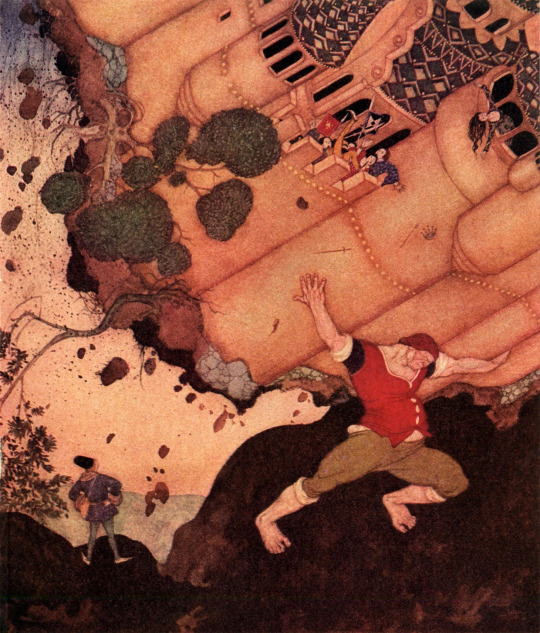
The Seven Conquerors of the Queen of the Mississippi: A Belgian Fairy Tale
While there may be an actual fairy tale underpinning The Seven Conquerors of the Queen of the Mississippi, the story’s title reveals Dulac’s probable agenda. It takes no large leap of the imagination to read the “seven conquerors” as Great Britain, France, Russia, Italy, Serbia, Japan, and China, all seeking an alliance with the Queen of the Mississippi—the United States—on the fields of Belgium.
The story is straightforward and structurally repetitive—each conqueror swears an oath of loyalty, and their individual strengths combine to win the Queen and kill the King (hello, Kaiser Wilhelm II).
Dulac, or some unnamed collaborator, has penned a verse that cuts through the first half of the tale with a modern rhythm and vocabulary.
“Will you travel with me, my pippy?” “Oh! Whither away? To Botany Bay?” “But no; to the far Mississippi, Where a Queen—tooral-ooral-i-ay— Is waiting for what I’m to say.” “I am yours! And the bounty?” “Either here or in Botany Bay!”
‘Will you travel with me, my pippy?” “Oh! Whither away? To Rome or Pompeii?” “But no; to the far Mississippi: There’s a Queen of great beauty that way, And there’s no one but Cupid to pay.” “I am yours! And the bounty?” “Name your price: it shall be as you say.” And so on. Travel with me, my pippy!
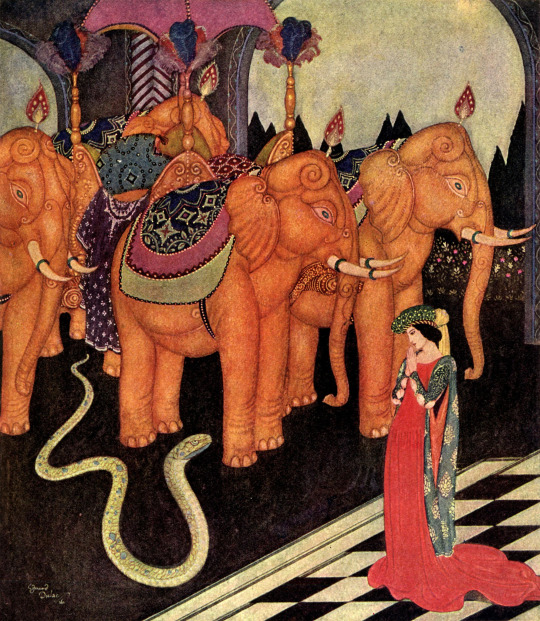
The Serpent Prince: An Italian Fairy Tale
The Italian poet Giambattista Basile collected The Serpent Prince (sometimes translated as The Enchanted Snake) in the seventeenth century, including it in The Pentamerone: Lo cunto de li cunti (The Tale of Tales). Folklorist Andrew Lang drew upon Basile’s version for The Green Fairy Book (1892).
Dulac has created his own prefatory material for the familiar story, opening with the popular nursery rhyme:
The old woman who lived in a shoe, Who had so many children she didn’t know what to do,
allegedly “lived about the same time in another part of the country” even though The Serpent Prince was collected in Naples.
As the story goes, a forester’s wife, Sapatella, finds a tiny serpent in her firewood. Childless, Sapatella is startled but amenable when the serpent offers himself up for adoption (“she was a kind-hearted woman and very, very lonely”).
The serpent grows—as children do—and soon demands a wife. And not just any wife! The serpent must marry the king’s daughter. Surprisingly, the king agrees to meet this demand. Or does he? He will give his daughter in marriage only if the adopted son-serpent can turn all the fruit in the royal orchards to gold.
It’s not clear why anyone is surprised that a talking serpent can wield the magic necessary to turn fruit into gold. Nor is it clear why the king would think the serpent would fail at any additional challenge placed before him. Turn the walls into diamonds and rubies? No problem. Turn the entire palace into gold? Absolutely (“not gold plate either: it was all solid gold of the purest kind.”). The king is forced to cede the battlefield. The princess will marry the serpent.
Of course, the serpent is really an enchanted prince, and here you would think the story would end: the affianced are wed, their kingdoms allied. But thanks to an additional foolish act by the king, the prince is again enchanted (and worse), and only the princess can save him. But will she be able to outwit the wily fox standing between her and her beloved?
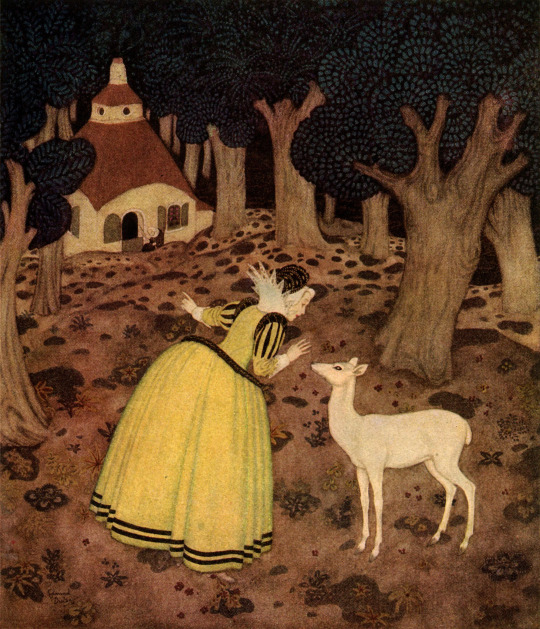
The Hind of The Wood: A French Fairy Tale
Dulac offers a faithful retelling of The Hind in the Wood (La Biche au bois, also translated as The White Doe or The Enchanted Hind), written by Marie-Catherine Le Jumel de Barneville, Countess d’Aulnoy. A talented and creative storyteller, Countess d’Aulnoy gave us the very words “fairy tale” in 1697, when she published her first collection under the title Les Contes des fees (Tales of the Fairies).
Though the titular hind is the star of the story, the scene opens with an unhappy, childless queen encountering a talking crayfish. Though “hearing a big Crayfish talk—and talk so nicely too—was a great surprise to her,” the queen listens carefully to the crustacean.
The reward for her attentiveness is a kingdom transformed. Beneath her feet appears “a carpet of violets, and, in the giant cedars above, thousands of little birds, each one a different colour, [singing] their songs; and the meaning of their melody was this: that cradle, woven by fairy fingers, was not there for nothing.” Soon she will be a mother!
A troupe of fairies gather around the suddenly expecting queen and ask that she welcome them on the day of birthing so they can give special gifts to the babe, who will be named Désirée. And on that special day, the queen indeed remembers to bid them come to the palace. Sadly, she neglects to invite the talking crayfish (who is really the Fairy of the Fountain) to the celebration.
Curses. But only small ones, in the scheme of things. The Fairy of the Fountain warns the royal parents to keep Princess Désirée from seeing daylight until she turns fifteen. That’s all.
Alas, the Warrior Prince lies on his death bed. Just a portrait of Désirée is enough to make him fall in love and abandon his plans to marry Black Princess. Yet he cannot see her—she will not be fifteen for a few more months. To save the Warrior Prince, Désirée agrees to travel with her two ladies-in-waiting by darkened carriage to his kingdom.
Unfortunately, one of those ladies-in-waiting, Long-Epine, is a traitor. She slits the cover of the carriage, exposing Désirée to daylight. Just a drop of sunlight turns the princess into a dazzling white hind. She instantly runs off into the forest. And that is the curse: by day, a doe; by night, a lonely princess.
The Warrior Prince wanders this very forest and soon spots the white deer. Annoyed that the animal tries to keeps its distance from him, he looses an arrow and pierces her flank. He’s sorry! Especially when he finds out the hind is his beloved, enchanted.
She isn’t enchanted for much longer, however. The Prince, even knowing all, loves her. And that is enough to break the spell
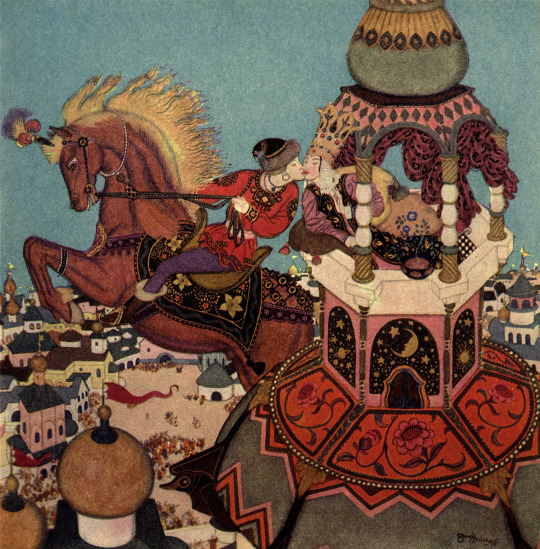
Ivan and the Chestnut Horse: A Russian Fairy Tale
Variations of Ivan and the Chestnut Horse are abundant in Russian folklore. Sometimes Ivan rides a chestnut horse, sometimes a dun. A common version of the story, known as Sivko-Burko, was collected by A. N. Afanas’ev in the mid-nineteenth century. Included in Jack V. Haney’s comprehensive The Complete Folktales of A. N. Afanas’ev (Tale #179, Vol. II), this version gives Ivan a magic black steed.
Ivan and his brothers have just committed themselves holding daily prayers over the grave of their recently departed father when they hear that Princess Helena the Fair has decided to wed. To win her favor, her suitor must leap on horseback to the top of the shrine on which she sits, kissing her as he flies through the air.
Ivan, the youngest of the siblings, offers to take on the burden of graveside prayer for a week so his brothers can curl their hair and train their horses for the challenge. One week stretches to two, and then to three. The brothers ignore their filial duties to dye their mustaches. So much attention is paid to their appearance that they even neglect to feed their horses.
And yet, when the day of the leaping contest arrives, the older brothers dash away on their mounts, leaving Ivan alone to pray and weep over his father’s grave.
It was thus that two out of three brothers miss their father’s resurrection. Shaking himself free of the damp earth, the father offers to help his youngest son. He begins to call out in a loud voice—one time, two times, three times. Ivan discovers his father is summoning a beautiful chestnut horse!
Yes, this is the enchanted steed that will take Ivan to the shrine of Helena the Fair, where—after two failed attempts—it rises to the leap, allowing Ivan to press his lips to those of the princess “in a long sweet kiss, for the chestnut horse seemed to linger in the air at the top of its leap while that kiss endured.”
After summoning the steed, Ivan’s father immediately vanishes. No matter, because Ivan is soon welcomed to supper with the father of his bride, Princess Helena the Fair.

The Blue Bird: A French Fairy Tale
The Blue Bird (l’Oiseau Bleu) is another tale that comes to us by Countess d’Aulnoy. Though there are many variants of the story found across Europe, scholar Jacques Barchilon notes that d’Aulnoy’s version is remarkably robust, appearing in a French Canadian collection, “word for word the version of Mme d’Aulnoy’s with all details,” as late as 1960. Andrew Lang also included it in The Green Fairy Tale Book.
Our story opens with a rich but miserable king. He’s inconsolable, having only recently become a widower. Hoping to comfort him, his courtiers present him with a woman dressed in mourning clothes and possibly crying even louder and longer than the king himself.
Finding solace in their similar sorrows, they decide to wed. Each brings into the marriage a daughter from their first marriage. The king’s daughter: “one of the eight wonders of the world,” the young and lovely Florine. The new queen’s daughter: “neither beautiful nor gracious,” the young Truitonne, with a face like a trout and hair “so full of grease that it was impossible to touch it.”
The queen loves Truitonne much more than she loves Florine, which wouldn’t matter if the king didn’t love the queen so much that he cedes to her every wish. For instance, he allows her to dress Truitonne in jewels and Florine in rags when Prince Charming appears at court. Despite the heavy-handed costuming, however, Prince Charming only has eyes—and love—for Florine.
The queen schemes. The queen plots. She enlists maid, frogs (“for mind you, frogs know all the routes of the universe”), and fairy godmothers. And yet the Prince will not be deflected from his plans to be with Florine. Finally, exasperated with his stubbornness, Truitonne’s fairy godmother turns the prince into a blue bird—for seven years!
It’s not too bad, at first. In bird form, the prince finds it easier to woo Florine—until the queen discovers that he flies to her window every night. Wielding her dark magic, Truitonne’s fairy godmother sends the blue bird to his nest to die.
Fortunately, every bad fairy seems to be balanced by a good fairy. This bright character finds the dying blue bird in his nest and heals him. It doesn’t seem to help much—the queen is determined that Truitonne will marry the prince even if only by trickery and deception.
The queen’s shenanigans never seem to end—this is a long fairy tale—but eventually the universe, or at the least the good fairy, finds a way to bring Prince Charming and Florine together.

The Friar and the Boy: An English Fairy Tale
The Friar and the Boy, also known as Jack and his Stepdame, reaches back to the poetry of medieval England. In volume three of Remains of the Early Popular Poetry of England (1866), William Carew Hazlitt records a c. 1585 London imprint of the chapbook verse that underpins the modern version of this tale.
The story begins with Jack, a young lad wronged by his stepmother. She starves him, she yells at him, she altogether doesn’t care for him.
One day, sent to the fields to watch the sheep, Jack encounters a hungry old man. Jack’s lunch isn’t much, as his stepmother is loathe to feed him decent food, but he gives it to the stranger. In return, the old man gives Jack three wishes.
Wish one: a bow and arrow, charmed such that the target will never be missed. Wish two: a pipe, its magic strong enough to make anyone dance who hears its tune. Wish three: an enchantment that will turn his stepmother’s harsh words into laughter.
Jack instantly puts his granted wishes to work. When his stepmother begins to scold him, her words turn to laughter. She laughs herself sick. When the Friar is sent to chastise Jack for his impudence, he ends up dancing through the brambles to Jack’s piping. Soon Jack has the entire village dancing to his tunes!
Alas, his poor old father begs for a rest. Jack loves his father, so he ceases to play. Not surprisingly, the Friar takes advantage of the pause to have Jack called before the Judge, “be-wigged and severe.”
The Friar makes his case: “the prisoner here has a pipe, and, when he plays upon it, all who hear must dance themselves to death, whether they like it or not.”
Intrigued, the Judge asks to hear this so-called Dance of Death. Jack is happy to oblige and takes up his pipe to play. Soon everyone in court is on their feet, dancing madly to the tunes. Even the judge joins in, “holding up his robes and footing it merrily.” He’s a believer, but he soon asks the boy to stop.
Jack agrees, but only if everyone promises to treat him properly.
“I think,” says the Judge, “if you will put your pipe away, they will consent to an amicable arrangement.”
Court is adjourned.
The End.
#edmund dulac#fairytale illustrations#fairytale art#french fairytales#british fairytales#english fairytales#edmund dulac's fairy book#world war I#wwI#fairytales and war#fairytale propaganda#russian fairytales#belgian fairytales#flemish fairytales#edmund dulac's fairy-book#italian fairytales#political fairytales
11 notes
·
View notes
Text

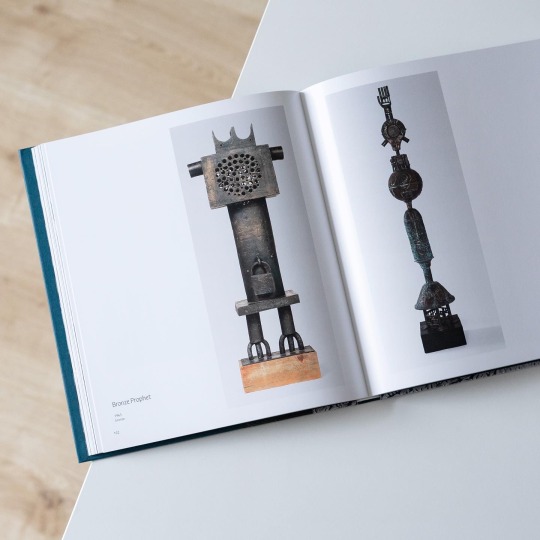
As a constant wanderer between the worlds of East and West Iranian sculptor Parviz Tanavoli (*1937) has developed a multilayered oeuvre that relates as much to history as it does to modernity. Trained both in Iran and Italy, he basically from scratch created modern sculpture in Iran upon returning from Italy in 1959 and shortly thereafter started teaching at Tehran College of Decorative Arts. Here he also became head of the sculpting department, a position he held until 1979 and which was only briefly interrupted by a two-year stay at the Minneapolis College of Art and Design, a brief but important residence as it got him in touch with Pop Art.
For the last two decades Tanavoli has been based in Vancouver and is currently being honored with a retrospective at Vancouver Art Gallery: titled „Poets, Locks, Cages“ the exhibition gathers more than 100 works from all periods of Tanavoli’s career also including prints, paintings and mixed-media assemblages. The exhibition’s title plays at the three major themes in the his work, namely the poet, the locks and the cages with which he creates a connection with pre-Islamic Iranian traditions. The poet e.g. represents his deep identification with poetry and the poet as "annunciator of freedom, peace and love.“ Locks on the other hand are both a pet issue of Tanavoli, who has long been a passionate collector of all kinds of historic locks, but also take on a symbolic role in his art: they codify genitalia, protection, prohibition but also serve as a symbol of healing and hope, just like they did on the grillwork of ancient temples and tombs. And just like the lock the cage in Tanavoli’s work takes on a different meaning that is more about safeguarding than imprisoning and also make for interesting shadow plays.
These insights (and more) a further elaborated in the catalogue accompanying the exhibition which has recently been published by Hirmer: it contains four insightful essays that beyond Tanavoli’s symbology also address the different contexts in which his work came about as well as the important role Abby Weed Grey played for his career in the US. A beautiful way to get to know this pivotal Iranian artist!
24 notes
·
View notes
Text







Adrian Piper wins the Golden Lion for best artist in Okwui Enwezor's biennial exhibition 'All the World's Futures', part of the 56th Venice Biennale, 2015 in Venice, Italy. (Photo by Awakening/Getty Images)
HAPPY BIRTHDAY 💫🌸❤
Adrian Margaret Smith Piper #bornonthisday (born September 20, 1948) is an American conceptual artist and Kantian philosopher. Her work addresses how and why those involved in more than one discipline may experience professional ostracism, otherness, racial passing, and racism by using various traditional and non-traditional media to provoke self-analysis. She uses reflection on her own career as an example. via Wikipedia
(2) Visiting artist, Adrian Piper, lecturing at the Minneapolis College of Art and Design, 133 East 25th Street, Minneapolis, Minnesota
3.Adrian Piper, Catalysis III
4.#AdrianPiper, Catalasys IV
5.Three Untitled Projects (1969), by Adrian Piper
6.Self-Portrait Exaggerating My Negroid Features (1981)
7.Decide Who You Are, #1: Skinned Alive (1991)
#womensart #artbywomen #PalianShow #botd #femaleartist #contemporary #conceptual #conceptualart
3 notes
·
View notes
Photo
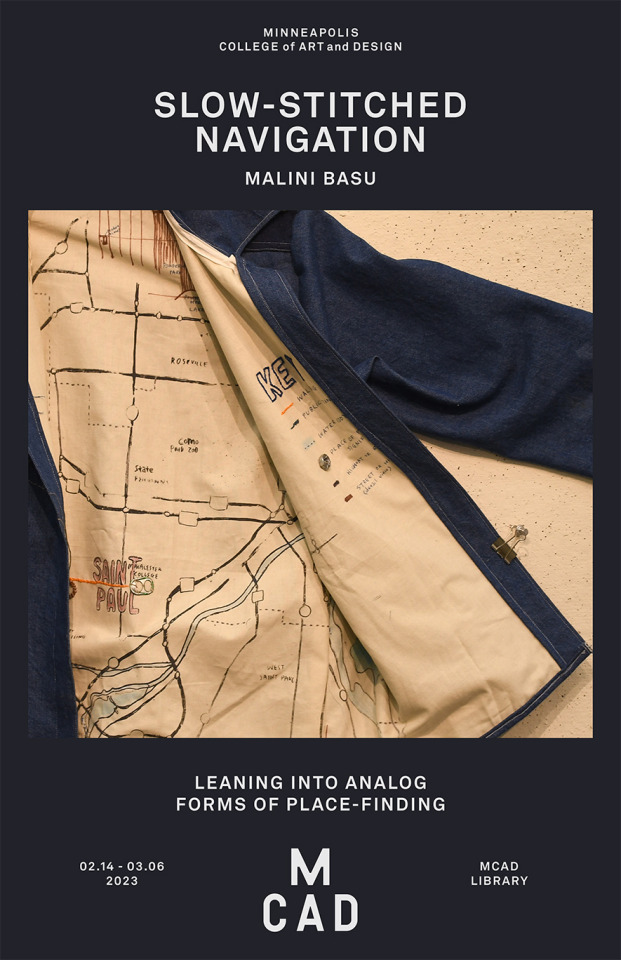
Slow-stitched Navigation
A Library Gallery exhibition by Malini Basu
We highly recommend making your way to see Malini Basu's exhibition: Slow-stitched Navigation, in the Library Gallery.
Exhibition: Tuesday, February 14–Monday, March 6 Library Gallery @mcad
Introduction to the installation by Malini Basu:
I have never been good at directions—short walks that should be second nature to me could turn into hour-long meanders. When I moved from my home in India to the Twin Cities, I embraced the GPS system on my phone wholeheartedly, enjoying the ease with which I was able to navigate the public transit systems and the city at large. I followed the guiding blue line unquestioningly, trusting that I was being fed the most efficient path. Unsurprisingly, my mindless navigation did not assuage the disconnect I felt towards the cityscape I walked in and land I lived on. In this body of work, I lean into slower modes of traversing the city. I focus on building an observational practice for myself, using objects found on the sidewalks as cues to look up and take note of my surroundings. I gradually build out my own mental map by tying the object to the surrounding intersection, the plants in season around me, the smells, the cracks in the sidewalks, my personal memories in that area. This practice led to tactile explorations of how I can connect my body to my movements through a place. While this project began as a response to navigating Minnesota, I was able to continue this mindful observation while in India this past winter. The works in this show thus reflect walks in both Minneapolis as well as Kolkata.
Recommended library books:
Wanderlust: Actions, Traces, Journeys, 1967-2017, by Rachel Adams, Rebecca Solnit, Lori Waxman, and Jane McFadden
The Map as Art: Contemporary Artists Explore Cartography, by Katharine A Harmon and Gayle Clemans
Walking and Mapping: Artists as Cartographers, by Karen O’Rourke
Walking Art Practice: Reflections on Socially Engaged Paths, by Ernesto Pujol
The Snowy Day, by Ezra Jack Keats
Fray: Art and Textile Politics, by Julia Bryan-Wilson
Drawing from Memory, by Allen Say (on order)
#maps#Minnesota#India#Kolkata#library gallery#mcad library gallery#library gallery @mcad#minneapolis college of art and design library#MCAD Library#mcad
9 notes
·
View notes
Photo

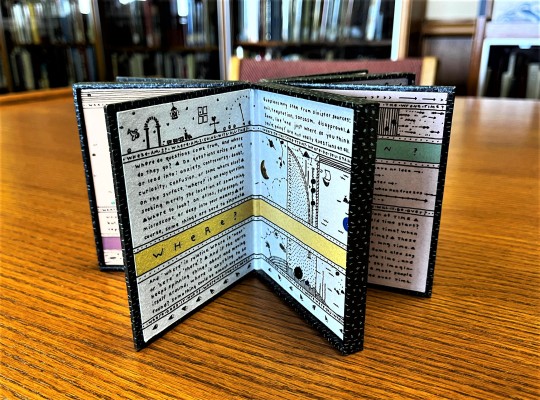

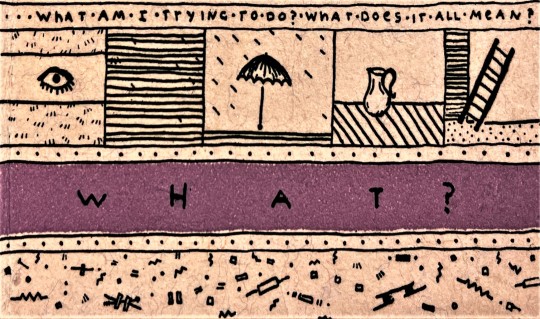
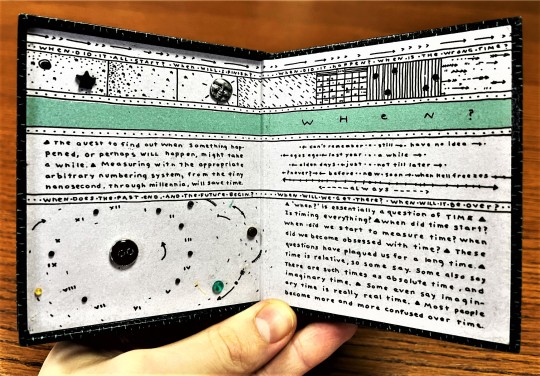

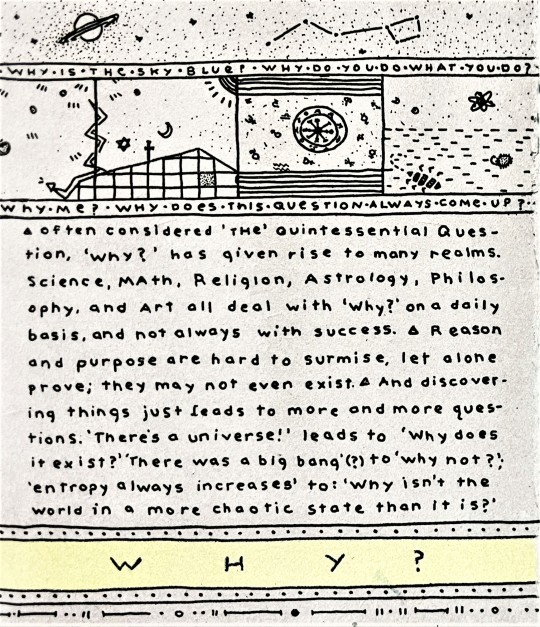
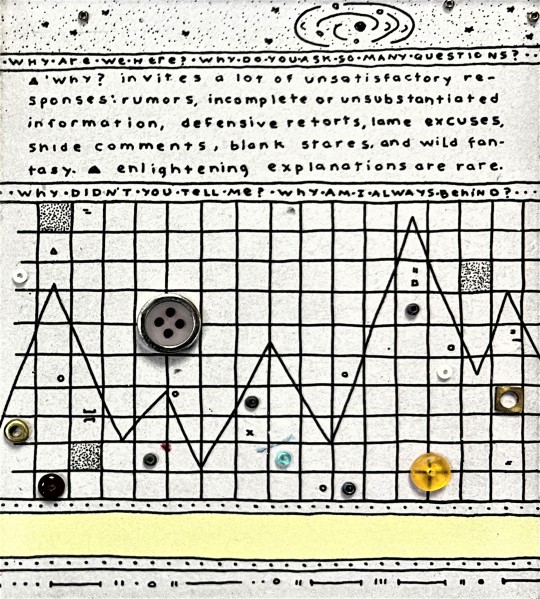
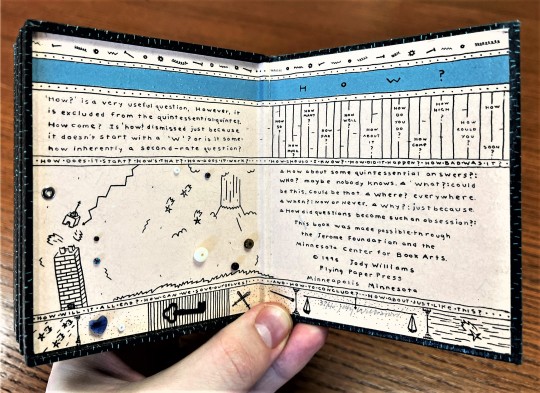
Staff Pick of the Week!
This week I am sharing Quintessential Questions, a small artist book by book artist, writer, and professor at the Minneapolis College of Art and Design, Jody Williams. The book is self-published under her imprint, Flying Paper Press, Minneapolis, 1996. I chose this artist book to highlight the exhibition in Special Collections which I just finished installing, called Jody Williams’s Flying Paper Press.
Jody Williams creates small artist books which take a variety of creative and engaging forms. Within her books she uses her own calligraphic letters which are friendly and inviting. Her books are also impeccably crafted, each cut and fold is perfectly measured and squared. Her illustrations are harmonious with the text, they are playful while depicting serious topics relating to our relationship with time, space, nature, language, and so on.
In this book Williams looks at our relationships to the interrogative words: who, what, where, when, why, and how. She highlights their uses and how they often mislead us, elicit unsatisfactory answers, or lead us into obsession, evasion, and more confusion.
Williams uses boxes as pages, allowing space for inclusions of buttons and beads into the composition. The text and images are made from etchings, which produce beautiful tactile lines on the toned papers. The cover paper is her own design.
View more posts on Artists Books!
View more posts on Jody Williams!
View more Staff Picks!
Teddy, Special Collections Graduate Intern
#Staff Pick of the Week#Quintessential Questions#Jody Williams#Artists books#Bookmaking#Book arts#who#what#where#when#why#how#Flying Paper Press#Mixed Media#Etching#Printmaking#Minnesota artists#Midwest Artists#small books#calligraphic fonts#book design#art and design#teddy
46 notes
·
View notes
Text







NEW COLLECTION
Whittier Alliance Records
Thanks to a pair of wonderful grant-funded staff members, Special Collections has a new, large neighborhood collection organized and ready for use -- the Whittier Alliance Records.
Founded in 1978 by the residents and business owners of the south Minneapolis Whittier neighborhood, Whittier Alliance was one of the first neighborhoods involved the city's Neighborhood Revitalization Program. The group's records include minutes, fundraising materials, legal records, housing and development plans, promotional materials, photos, and much more in 110 boxes and three oversize folders. Topics include specific businesses and addresses, schools and projects in the neighborhood, and local institutions like the Minneapolis College of Art and Design and Eat Street. Search the online finding aid to learn more.
9 notes
·
View notes
Text
more than 200 of which you can view in high resolution and download from the “Art of the Poster 1880-1918,” a Flickr collection assembled by the Minneapolis College of Art and Design.
6 notes
·
View notes